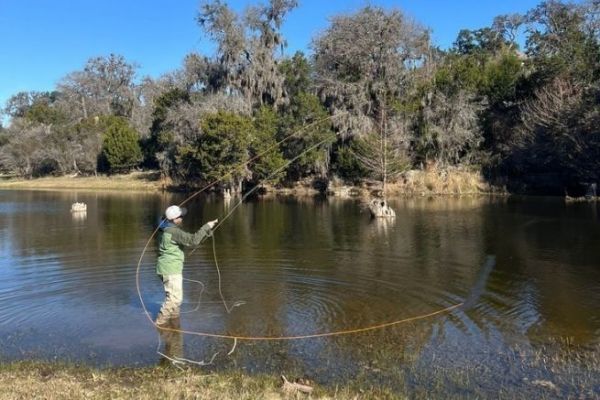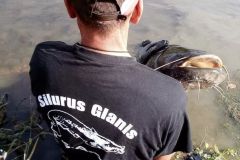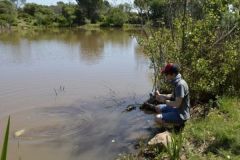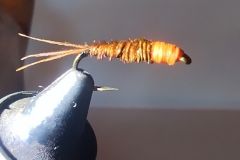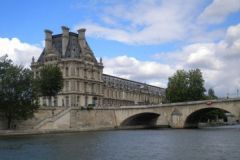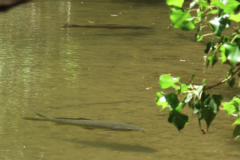I'm lucky enough to know Jérôme, a true casting enthusiast. He can't stop talking about it, and is always on the lookout for the perfect cast. He's also passionate about fly-fishing, but is able to "sacrifice" fishing time at the water's edge for casting practice. It's a real treat to watch him at work, whether it's the fluidity of his movements or the impressive casting distances. He has an expert eye and is always ready with advice, and practising with him is always a learning experience. But I'm in a good position to know that a good teacher isn't enough to be a good thrower.
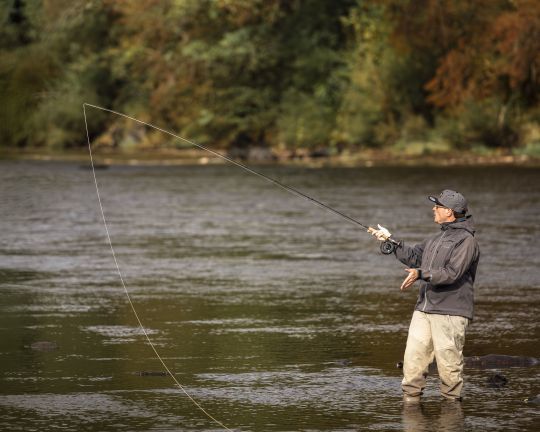
Hello Jérome, can you introduce yourself in a few words?
Hello Alex, and thank you for this interview! In a few words: climatologist by trade, fly-fisherman since I was 5 years old, in love with casting since I was a teenager, and happy founder of the Fly Casting Lab (FCL). And I say "happy", because it's a real pleasure to have been able to create this framework, which enables me to practice, exchange and pass on this passion. I'm also a Casting Instructor with Fly Fishers International. This certification has helped me enormously in my practice and in my understanding of casting, and above all, of teaching it.
How did you get started in fly fishing?
What a symbol: in a parking lot! It was the son of a friend of my parents, David Maillard, who helped me make my first throws by accompanying me to the small parking lot next to his mother's store. I was lucky enough to grow up very close to a magnificent river, the Guiers, which was the cradle of the passion we still share today. It was also on the banks of this river that, at the age of eight, I met my other mentor, Jean Avril. Jeannot was, and still is, at 95, one of the most important people in my life.
I started fly-fishing on the Guiers river, with my brother Emilien, dry-fishing for "brodes". I also clearly remember my first river trout, caught on a red palmer with cockles and wings (at the time, it seemed very important to put wings on a palmer), at Pont de Beauvoisin.
After that, my brother and I evolved a lot thanks to a whole group of anglers, around Jeannot, and Jean-Pierre Anderlini, a retailer in Chambéry and fly poet, who organized a big gathering every year. And it was with Jeannot's unstinting support that I prepared for and won the 2001 French Youth Championship, with, among other things, distance casting sessions on the banks of the Vieux Rhône in winter, while waiting for the gobbles.
To sum up: I've been extremely well looked after!
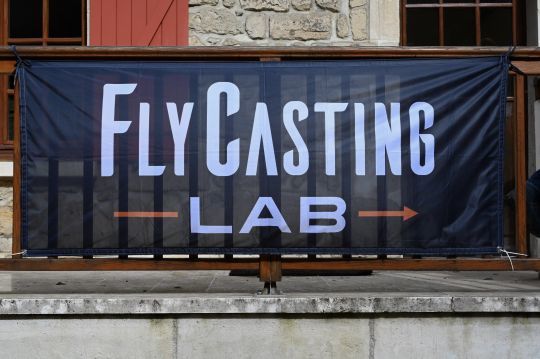
Can you tell us about the Fly Casting Lab?
The FCL aims to promote the discipline of fly casting, in all its forms. It began as a Facebook group in 2019, with the modest aim of creating a community of fly casting enthusiasts in France. The group has since exploded, with more and more international expert casters joining in the discussions, and it's now the biggest Facebook group in the world on the subject of fly casting. Everyone is welcome to ask questions, whatever their level, and the atmosphere is very friendly.
The FCL is now made up of 5 people:
Laurent Keiff and myself are the founders, and are responsible for the running of this joyful initiative. Malik Mazbouri and François Biétry from SIM Suisse (Italian casting) joined us later, and have contributed enormously to the FCL with their expertise and dynamism. And Dylan Braillard from Discovery Fly Fishing, who brings us a strong link between casting and river fishing in Franche Comté.
The whole gang is now certified Casting Instructor FFI, and is preparing for the Master Casting Instructor. Over the past 2 years, the FCL has also become an association, to enable us to organize events and finance our operations.
How did this idea come about?
FCL was born in several stages.
First, there were our wild casting sessions at trade shows with Eric Arbogast, an excellent pitcher from Luxembourg. We'd get together year after year, and each time I'd say to myself: it's cool to cast with a friend.
Then there was the evening with Grégoire Juglaret (whom I knew from my time on the French youth team with him), when we came to ask ourselves: how far can you throw with a floating 5-gauge? That's where the dynamic around distance, emulation and the need to understand casting came from.
Finally, there was the closure of the La Maison de La Mouche store, which for five years had provided me with an ideal setting to share casting sessions with other regulars, and to offer one casting event a month. This closure left a huge void, which triggered a strong need to create my own structure, my own group, to bring together friends to cast.
Being a scientist, this dimension was necessarily part of the project. And it was with this in mind, and building on the foundations described above, that I opened the Facebook page that bears the name Fly Casting Lab.
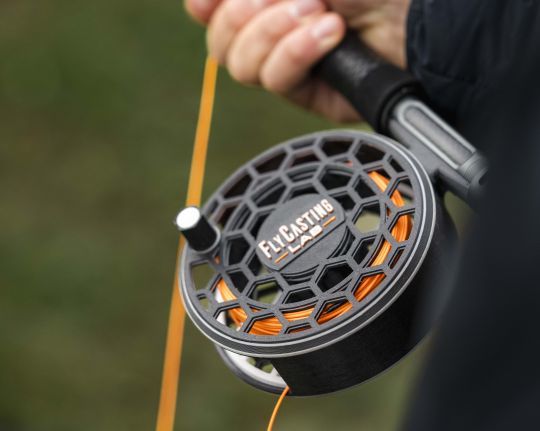
What are the club's objectives?
FCL's objectives are best described through its pillars:
- The scientific approach, which translates here in two ways:
1/ Our understanding of fly-casting mechanics is based as much as possible on physics
2/ The scientific quality of the argumentation and demonstration is more important than the person putting it forward; promoting this scientific approach is a goal in itself,
- Exchanges: the Facebook group was created to encourage exchanges between enthusiasts and to create emulation around the practice of fly casting.
- The challenge: pushing back your limits means constantly striving to evolve. For the past three years, we've organized a distance casting competition on floating 5-string (the Open Trout Distance Fly Casting Lab) during the Fête de la Pêche et de la Dordogne in Argentat, in October This competitive dimension allows us to push our understanding of throwing to the limit.
- Passing on and teaching: all this knowledge would be meaningless if it wasn't passed on; FFI Casting Instructor certification has increased our interest in teaching tenfold, and today the FCL is keen to pass on its knowledge, in the Facebook group, but also through videos, demonstrations at shows (Argentat, Hesdin, Roselies, Gabalitana), and courses at the Domaine de Coyolles.

In short, our objectives are to keep the Facebook group alive, organize events at trade shows and training courses, and promote fly casting in all its forms.
How do you see the future for FCL?
For a start, we'll be very happy if we can maintain our current momentum and develop the content of our courses and demonstrations. We have to keep challenging ourselves.
We'd also be delighted to help this casting culture grow in France, by helping people interested in Casting Instructor FFI certification to prepare (as we've already started to do). Please don't hesitate to contact us if you're interested!
There are also video projects, which we hope to see come to fruition, but which require a major investment of time. For the moment, we're already busy preparing for the Master Casting Instructor FFI certification, which represents a huge volume of work. And when that's done... We'll probably take a look at the Swiss SIM certification, so that we can continue to evolve in casting ourselves.
And as for the competition... We hope that the Argentat Open Trout Distance will grow in stature, and why not inspire the creation of a national circuit, which would enable us to create a team to take part in the world championships!
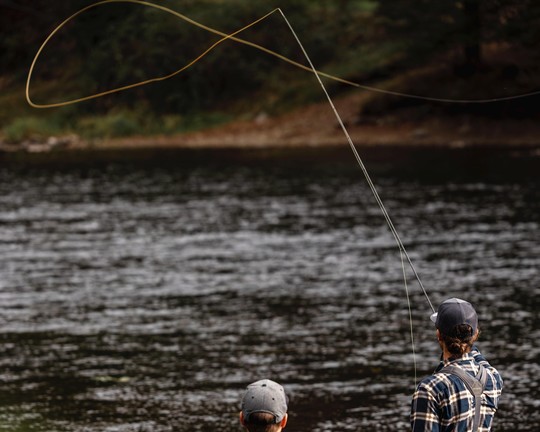
Finally, can you give us a little advice for those who want to improve their throwing distance?
We like to say at the FCL that throwing far is above all about throwing well. Behind this simplistic statement, you have to read: master the fundamentals of casting, practice, and the meters will come all by themselves. Take an interest in Bill Gammel's 5 essentials, look at your line when you cast, know how to read the shape of your loop: your aim is to have a loop of line with both sides as smooth as possible, and in the same plane. Identify when faults occur (such as tailing loops, or when the upper part of the loop slips over the side instead of staying in line with the target), and take the time to analyze why they occur. Don't hesitate to ask questions on the FCL Facebook page to get some ideas for your work!
Then use the double pull. Practice at all distances, from 5 m to 20 m: a real silk gas pedal, it's a bonus in any situation. There are some great exercises you can do to learn and perfect your double pull.
Finally, if you're casting cleanly and have an effective double pull, the next step is to increase the amplitude of your strokes while maintaining the quality of your casts. Only add speed as a last resort; your technique should be the primary reason for your distance gain. If you follow all this, your backing should be coming along nicely!
(You told me ONE little tip, there's a bit more, I couldn't resist)...
Thank you very much for your advice and time, Jérôme. I wish you every success with your projects and hope to see you soon at the water's edge.
Thank you and see you soon!

 /
/ 